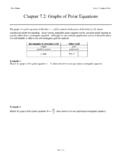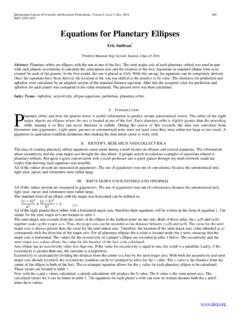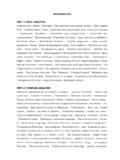Transcription of Section 9.2 – Polar Equations and Graphs
1 180 Section Polar Equations and Graphs In this Section , we will be graphing Polar Equations on a Polar grid. In the first few examples, we will write the Polar equation in rectangular form to help identify the type of Equations we have and then sketch the graph . Objective 1: Identify Polar Equations and graph Convert the Polar equation to rectangular and sketch the graph : Ex. 1 r = 5 Solution: r = 5 (square both sides) r2 = 25 (replace r2 by x2 + y2) x2 + y2 = 25 This is a circle of radius 5 centered at the Pole. = 4 Solution: = 4 (take the tangent of both sides) tan( ) = tan( 4) = 1 (tan( ) = yx) yx = 1 y = x This is a line with slope of 1 passing through the Pole.
2 2 3 4 4 0 1 2 3 4 5 5 4 7 4 3 2 181 Ex. 3 rsin( ) = 4 Solution: rsin( ) = 4 (y = rsin( )) y = 4 This is a horizontal line passing through (0, 4). Ex. 4 rcos( ) = 2 2 3 4 4 0 1 2 3 4 5 5 4 7 4 3 2 2 3 4 4 0 1 2 3 4 5 5 4 7 4 3 2 182 Solution: rcos( ) = 2 (x = rcos( )) x = 2 This is a vertical line passing through ( 2, 0).
3 Theorem If a 0, then 1) rsin( ) = a is a horizontal line that passes through (0, a). 2) rcos( ) = a is a vertical line that passes through (a, 0). Convert the Polar equation to rectangular and sketch the graph : Ex. 5 r = 2sin( ) Solution: r = 2sin( ) (multiply both sides by r) r2 = 2rsin( ) (r2 = x2 + y2 and y = rsin( )) x2 + y2 = 2y (subtract 2y from both sides) x2 + y2 2y = 0 (complete the square; add 1 to both sides) x2 + y2 2y + 1 = 1 (write y2 2y + 1 as (y 1)2) x2 + (y 1)2 = 1 This is a circle with radius of 1 centered at (0, 1). 2 3 4 4 0 1 2 3 4 5 5 4 7 4 3 2 183 Ex.
4 6 r = 4cos( ) Solution: r = 4cos( ) (multiply both sides by r) r2 = 4rcos( ) (r2 = x2 + y2 and x = rcos( )) x2 + y2 = 4x (add 4x from both sides) x2 + 4x + y2 = 0 (complete the square; add 4 to both sides) x2 + 4x + 4 + y2 = 4 (write x2 + 4x + 4 as (x + 2)2) (x + 2)2 + y2 = 4 This is a circle with radius of 2 centered at ( 2, 0). 2 3 4 4 0 1 2 5 4 7 4 3 2 2 3 4 4 0 1 2 3 4 5 5 4 7 4 3 2 184 Circles in Polar Coordinates: 1) r = a This a circle of radius a centered at the Pole.
5 2) r = 2asin( ) This a circle of radius a centered at (0, a). 3) r = 2asin( ) This a circle of radius a centered at (0, a). 4) r = 2acos( ) This a circle of radius a centered at (a, 0). 5) r = 2acos( ) This a circle of radius a centered at ( a, 0). Objective 2: Test for Symmetry in Polar Coordinates. When graphing functions, we sometimes found it helpful to use symmetry to help construct the graph . We checked to see if the function was : 1) Symmetric with respect to the x9axis, 2) Symmetric with respect to the y9axis, or 3) Symmetric with respect to the origin. We can do the same thing in Polar coordinates, but instead of using the x9axis, y9axis, and the origin, we will be using the Polar axis, the = /2 line, and the pole.
6 With this tests listed below, it is possible for a test to fail, but the function to still exhibit that particular symmetry, Tests for Symmetry in Polar Coordinates: 1) Polar Axis Symmetry (x9axis) (r, ) Replace by . If the resulting equation is equivalent to the original equation, then the graph is symmetric with respect to the Polar axis. (r, ) 2) Line = 2 Symmetry (y9axis) (r, ) (r, ) Replace by . If the resulting equation is equivalent to the original equation, then the graph is symmetric with respect to the line = 2.
7 (r, ) 3) Pole Symmetry (origin) Replace r by r. If the resulting equation is equivalent to the original equation, then the graph is symmetric with respect to the pole. ( r, ) 185 Objective 3: graph Polar Equations by Plotting Points. graph the following: Ex. 7 r = 2 2cos( ) Solution: First, we apply the tests for symmetry: Polar Axis (replace by ) r = 2 2cos( ) (cosine is an even function) r = 2 2cos( ) This is an equivalent equation so the graph is symmetric with respect to the Polar axis. Line = /2 (replace by ) r = 2 2cos( ) (cosine of a difference of angles) r = 2 2[cos( )cos( ) + sin( )sin( )] r = 2 2[( 1)cos( ) + (0)sin( )] r = 2 + 2cos( ) This test fails.
8 Pole (replace r by r) r = 2 2cos( ) r = 2 + 2cos( ) This test fails. Since the function is symmetric with respect the Polar Axis, we need to just plot the function for values of between 0 and inclusively and then reflect it across the Polar axis. r = 2 2cos( ) 0 r = 2 2cos(0) = 2 2 = 0 6 r = 2 2cos( 6) = 2 3 4 r = 2 2cos( 4) = 2 2 3 r = 2 2cos( 3) = 2 1 = 1 2 r = 2 2cos( 2) = 2 0 = 2 2 3 r = 2 2cos( 2 3) = 2 + 1 = 3 3 4 r = 2 2cos( 3 4) = 2 + 2 5 6 r = 2 2cos( 5 6) = 2 + 3 r = 2 2cos( ) = 2 + 2 = 4 186 Now, we will plot the points and then draw a smooth curve through the points: Finally, use symmetry to get the rest of the graph : This curve is called a Cardioid (heart9shaped curve).
9 These types of curves are in the form of: r = a acos( ) or r = a asin( ) where 0 < a 2 3 4 4 0 1 2 3 4 5 5 4 7 4 3 2 2 3 4 4 0 1 2 3 4 5 5 4 7 4 3 2 2 3 4 4 0 1 2 3 4 5 5 4 7 4 3 2 187Ex.
10 8 r = 3 + 2sin( ) Solution: First, we apply the tests for symmetry: Polar Axis (replace by ) r = 3 + 2sin( ) (sine is an odd function) r = 3 2sin( ) This test Line = /2 (replace by ) r = 3 + 2sin( ) (sine of a difference of angles) r = 3 + 2[sin( )cos( ) cos( )sin( )] r = 3 + 2[(0)cos( ) ( 1)sin( )] r = 3 + 2sin( ) This is an equivalent equation so the graph is symmetric with respect to the line = /2. Pole (replace r by r) r = 3 + 2sin( ) r = 3 2sin( ) This test fails. Since the function is symmetric with respect the line = /2, we need to just plot the function for values between /2 and /2 inclusively and then reflect it across the line = /2.






